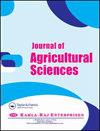Assessment of the Seedling Resistance of Spring Wheat Lines to Fusarium culmorum
IF 0.7
Q3 AGRICULTURE, MULTIDISCIPLINARY
引用次数: 6
Abstract
Wheat diseases are one of the constraints limiting wheat yields wherever the crop is grown. Fusarium crown rot, incited by Fusarium culmorum, is one of the most important diseases limiting wheat yields especially in dryland areas. Although there are no wheat varieties which are fully resistant to crown rot, the use of varieties showing some degree of resistance is the most reliable and cost effective method to control this disease. In this study, seedling reactions of 165 spring wheat breeding lines (Triticum aestivum L.) obtained from CIMMYT, Mexico were determined under growth room conditions using an aggressive isolate of Fusarium culmorum. Crown rot severity was assessed using a 1-5 scale. The mean disease severity scores for the lines tested ranged from 1.4 to 4.4. Two out of the 165 lines tested (lines 147 and 158) were resistant (R) in their reaction and had scores of 1.4. Twenty lines showed moderately resistant (MR) reaction and had scores ranging from 1.6 to 2.4. The scores of both the R and MR lines were not significantly different from scores of MR control cultivars. Sixty-three percent of the lines were moderately susceptible (MS). Out of the 165 lines tested, 39 were susceptible (S) in their reaction. The promising wheat lines that showed some degree of resistance to Fusarium culmorum in the present study can serve as useful sources of genetic resistance in breeding for Fusarium crown rot.春小麦品系苗期对镰刀菌抗性评价
无论在哪里种植小麦,小麦病害都是制约小麦产量的因素之一。镰刀菌引起的枯腐病是限制小麦产量的主要病害之一,特别是在旱地地区。虽然目前还没有完全抗冠腐病的小麦品种,但选用具有一定抗冠腐病能力的品种是防治冠腐病最可靠、最经济的方法。本研究以墨西哥CIMMYT提供的165个春小麦选育品系(Triticum aestivum L.)为材料,在室内生长条件下,采用一种具有侵染性的镰刀菌分离株进行了幼苗反应测定。采用1-5分制评估冠腐严重程度。测试品系的平均疾病严重程度评分从1.4到4.4不等。在165个被测试的品系中,有两个品系(147和158)在反应中具有耐药性(R),得分为1.4。20个品系显示中度耐药(MR)反应,评分在1.6到2.4之间。R系和MR系的分数与MR对照品种的分数差异不显著。63%的品系为中度易感品系(MS)。在165个测试品系中,有39个对其反应敏感。本研究中对镰刀菌有一定抗性的小麦品系,可作为选育镰刀菌冠腐病遗传抗性的有用资源。
本文章由计算机程序翻译,如有差异,请以英文原文为准。
求助全文
约1分钟内获得全文
求助全文
来源期刊

Journal of Agricultural Sciences
AGRICULTURE, MULTIDISCIPLINARY-
CiteScore
1.80
自引率
0.00%
发文量
0
 求助内容:
求助内容: 应助结果提醒方式:
应助结果提醒方式:


